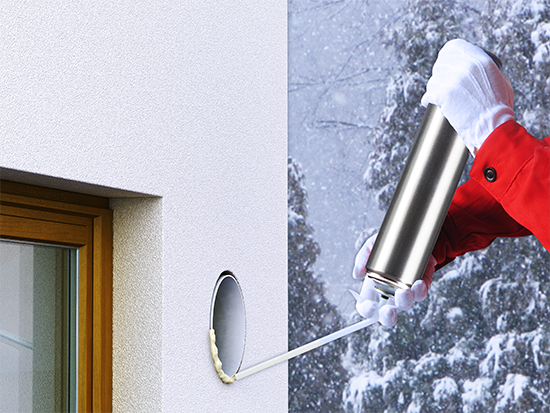Although there are elements of seasonality in the construction industry, work on major projects is practically never interrupted. Activity on construction sites during winter is just as intense as it is during summer. If the job requires it, concrete is poured and windows are installed even when temperatures are very low. Only a prolonged period of frost may result in a shutdown. Efficiency is ensured by the use of the correct techniques and products that are suitable for winter conditions.
In the case of polyurethane foams, a distinction can be made between regular foams, All Season, and winter foams. Regular foams are intended for use at temperatures as low as + 5 °C. In the case of mild winters, where temperatures fall only slightly below freezing (down to -5 °C), year-round foam is suitable. In the case of considerably low temperatures, down to -10 and even -20 °C, special winter foams are used. The composition of winter foams takes into account the winter conditions, and a high-quality end result is obtained despite negative temperatures and low humidity.
The use of weather-appropriate construction foam alone does not guarantee a good result, the temperature of the can is also important. It must not be colder than + 5 ° C. The structure and properties of the foam, and the yield, depend on the temperature of the foam can. For best results, the optimum can temperature is +10 to + 20°C. If the site does not have a warm room in which cans can be stored before use, they can also be wamed for a short time in water at a temperature of up to + 30 °C.
Winter foam application begins with the removal of dust and loose particles from the joint surface and, if necessary, removal of ice too. The joint must be protected from direct precipitation, snow or slush. Moistening of the joint is not necessary in winter conditions, and due to the risk of icing it is wise to avoid applying water. Low humidity has already been taken into account in the composition of winter foam. A frost-resistant foam activator can be used to accelerate foam production and improve adhesion and foam structure. The technique for foam application does not depend on the season. Traditionally, the foam is applied from the bottom up, in a zigzag pattern.
In cold weather, it must be taken into account that it requires on average three times longer for the foam to cure, usually up to 24 hours. At very low temperatures, brittleness of the surface layer can be observed during the first hours of curing, but one should not be discouraged by this as it is only a temporary phenomenon.
Bitter cold does nothing to the foam once hardened; even so, it is still recommended that foam once applied be covered after final curing, to protect it from UV radiation.
If any winter foam is left over, it can be used in warmer weather. However, it should be noted that in summer conditions the expansion pressure of winter foam is higher, and surfaces should definitely be moistened in order to reduce this. On the other hand, if you attempt to perform work with summer foam at temperatures below freezing, you will not obtain a proper joint. The foam collapses and does not cure.
Please note:
- Choose a product that suits the weather.
- In winter conditions, foam cures more slowly.
- Only trim excess foam when it is completely hardened.
Wolf Group winter foams portfolio
- Winter foams range includes formulations up to -18°C, and even -20°C for use in especially harsh conditions.
- Choose All season foams when temperatures are slightly below freezing, a minimum of -5°C. Foam adhesives are also well suited to such conditions.
Text: Maria Ševeljova, Product Manager




